Serbs of Bosnia and Herzegovina
| Total population |
|---|
| 1,100,000 33% (est. 2010) |
| Religion |
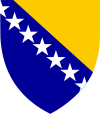 This article is part of the series: |
|
Bosnian Serbs are one of the three constitutive nations of Bosnia-Herzegovina, predominantly concentrated in the Republika Srpska entity, although many also live in the other entity called the Federation of Bosnia and Herzegovina. They are frequently referred to as Bosnian Serbs in English, regardless of whether they are from Bosnia or Herzegovina.
Contents |
Population
The last estimate is that Serbs form about 33% (2000) of the total population of Bosnia and Herzegovina. The vast majority live on the territory of the Republic of Srpska, and West Bosnia and Una-Sana cantons of the Federation of Bosnia and Herzegovina. Bosnian Serbs are the most territorially widespread nation of Bosnia and Herzegovina. The majority of Bosnian Serbs are adherents of the Serbian Orthodox Church, while some are atheists. The Bosnian Serbs of Bosnia and Herzegovina speak the Serbian language in its Jekavian and Ijekavian variant, similar to that of Montenegro and Croatia. Their total population world wide is estimated to be over 2 million.
History
Medieval
Serbs settled the region of Bosnia during the first half of the 7th century. They were led by the Unknown Archont and given Bosnia as a land to settle in by Byzantine Emperor Heraclius. Historical records indicate there were two small Serb inhabited cities, Kotor and Desnik, in Bosnia. Bosnia was ruled by Bans and in 753 formed a territorial union with the Principality of Rascia known as Serbia (Surbia, the region called Zagorje) ruled by Grand Princes.
According to the Royal Frankish Annals, in 822, Ljudevit Posavski, the ruler of Pannonia went from his seat in Sisak to the Serbs somewhere in western Bosnia who controlled a great part of Dalmatia ("Sorabi, quae natio magnam Dalmatiae partem obtinere dicitur").[1]
The western regions were incorporated into the Croatian state and some Bosnians were later baptised into Christianity by Byzantine missionaries (later Saints) Cyril and Methodus.
The Bosnian Chiefs abandoned the War-of-the-succession-torn Kingdom of Croatia and joined the Serbian Realm of Prince Časlav of Klonimir of the House of Vlastimir up to 931. By the end of the 948 Croatian struggles for the throne, he included all the territories to the river of Vrbas to the west and Sava to the north while western and northern Bosnia remained in the Kingdom of Croatia. The Drina area became the heart of his state. The Hungarian Kingdom had pretensions to conquer Bosnia, so Caslav was forced to fend-off a Hungarian invasion in 955. Prince Ceslav saved Bosnia, but was drowned by Hungarian forces in the river of Sava in northern Bosnia in the year 960.
The Bosnian Serbian rule in eastern and central Bosnia crumbled after Ceslav's fall. It would take Serbian King Constantine Bodin of Doclea and war against the Byzantines in 1082-1085 to restore it. There he installed a related courtier named Stefan as Ban, whose heirs continued to rule Bosnia.
Modern
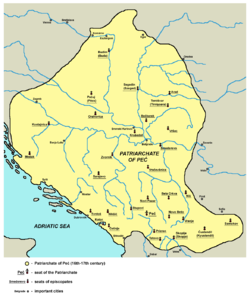
In 1878, Bosnia and Herzegovina became a protectorate of Austria-Hungary, which the Serbs strongly opposed. On June 28, 1914, 525th year anniversy of the sacred Battle of Kosovo Battle of Kosovo, Bosnian Serb Gavrilo Princip made international headlines after assassinating Arch Duke Francis Ferdinand in Sarajevo. This sparked World War I leading to Austria-Hungary's defeat and the incorporation of Bosnia and Herzegovina into the Kingdom of Yugoslavia.
During the Second World War, Bosnian Serbs were put under the rule of the fascist Ustaša regime in the Independent State of Croatia. Under Ustaša rule Serbs along with Jews and Roma people, were subjected to systematic genocide, known as the Serbian genocide, where hundreds of thousands of civilian serbs were murdered.[2]
Between 1945 and 1948, following World War II, approximately 70,000 Serbs migrated from the People's Republic of Bosnia and Herzegovina to Vojvodina after the Germans had left. Serbs were the larger of the two constitutive nations of Bosnia and Herzegovina (later the second largest of three, when Bosniaks, then known as Muslims by nationality, gained constitutive status in 1968).
- In the first population census conducted in the People's Republic of Bosnia in 1948, there were 1,136,116 Serbs for a total of 44.3% of BiH's population
- In 1953, there were 1,264,372 Serbs in BiH, equaling 44.4% of the total population.
- In the 1961 population census, there were 1,406,057 Serbs, accounting for 42.9% of the total population of the Socialist Republic of Bosnia and Herzegovina
This was problematic in that remaining part of the Federal Republic of Yugoslavia would have ignored the will of the other two constitutive nations. The Government of BiH declared independence anyway - which was not accepted by the federal Serb controlled government of Yugoslavia, and what followed was the forming of the Serbian Autonomous Area of the Bosnian Frontier in the western Bosnian Frontier region of Bosnia and Herzegovina with its capital in Banja Luka, which was not recognised by the central government. SAO Bosnian Frontier made attempts to unite with the Autonomous Region of the Serbian Frontier in Croatia. The Serb political leadership martialled its own force assisted by the Yugoslav People's Army and declared independence from Bosnia and Herzegovina in late 1992. During this period there was notable support for the idea of a Greater Serbia being made reality, both within Bosnia and in Serbia proper. This ideology advocated the joining of Serb-populated regions into a contiguous territory. BiH's Bosniak and Bosnian Croat dominated government did not recognize the new Serbian Republic of Bosnia and Herzegovina, whose president was Radovan Karadžić seated in Banja Luka. The Serb side accepted the proposed ethnic cantonization of Bosnia and Herzegovina (the Carrington-Cutileiro peace plan), as did the Bosniak and Bosnian Croat sides in Lisbon in 1992, in the hope that war would not break out. The Bosniak political leadership under President Alija Izetbegović of Bosnia and Herzegovina subsequently revoked the agreement refusing to decentralize the newly created country based on ethnic lines. The Bosnian War began.
Throughout most of the war the Serbs fought against both the Bosniaks and the Bosnian Croats. During Bosniak-Croat hostilities the Serbs co-operated largely with the Croats. There were exceptions to this however, as Serb forces were also allied with the pro-Yugoslav Bosniaks of the Autonomous Province of Western Bosnia under Fikret Abdić. During most of the war, the Serb Republic comprised around 70% of Bosnia and Herzegovina's soil. During the entire length of war the Army of the Serb Republic maintained the Siege of Sarajevo, allegedly in order to tie down the Bosnian Muslim (Bosniak) forces and resources in what was the capital of the Bosnian-Herzegovinian state. Serb Republic maintained close ties with the Republic of the Serb Frontier and received volunteers and supplies from the Federal Republic of Yugoslavia during the war. The Serb Republic received a large number of Serb refugees from other Yugoslav hotzones, particularly non-Serb held areas in Sarajevo, Herzeg-Bosnia and Croatia. In 1993, the Owen-Stoltenberg peace treaty was suggested that would give 52% of BiH to the Serb side. It was refused by the Bosniak side as too large of a concession.
In 1994, the Federal Republic of Yugoslavia imposed sanctions after the National Assembly of the Serb Republic refused the Vance-Owen peace plan. In 1995, Operation Storm eliminated the Republic of the Serb Frontier. The Croatian Army continued the offensive into the Serb Republic under General Ante Gotovina (currently on trial for war crimes at the ICTY). Some 250,000 Serbs fled to the Serb Republic and Serbia from Croatia, as the Serb side continued a full retreat of Serbs from the Una to the Sana river. The Croatian Army, supported by the forces of the Muslim-Croat Federation of Bosnia and Herzegovina came within 20 km of the de facto Bosnian Serb capital, Banja Luka. The war was halted with the Dayton Peace Agreement which recognized Republika Srpska, comprising 49% of the soil of BiH, as one of the two territorial entities of the Republic of Bosnia and Herzegovina. The Serb side suffered a total 30,700 victims - 16,700 civilians and 14,000 military personnel, according to the Demographic Unit at the ICTY. Although exact numbers are disputed, it is generally agreed that the Bosnian War claimed the lives of about 100,000 people - Serbs, Croats and Bosniaks. See: Casulties of the Bosnian War
The demographics of Bosnia-Herzegovina as well as Republika Srpska were tremendously affected by the war. Current estimates indicate that some 400,000 Serbs no longer live in the Federation of BiH. By the same token, it is estimated that some 450,000 Bosnian Muslims (Bosniaks) and Bosnian Croats that used to live in Republika Srpska no longer live there. Many Bosnian Serbs emigrated abroad to Canada, the United States, Australia, western Europe, Serbia and Montenegro.
Culture
The Serbs in Bosnia and Herzegovina use regional names among each other, such as the wider: Frontiersmen (Krajišniks), Semberians, Bosnians, Herzegovinians
Folk attire
Dance
Music
Herzegovinan clans
Some of Bosnia and Herzegovina's Serbs, mostly living in Herzegovina are organised in clans. The Herzegovinian clans are:
- Grahovo
- Rudine
- Bijele Nikšićke Rudine
- Oputne Rudine
- Bilećke Rudine
- Banjani
- Lukovo
- Nikšićka Župa
- Gornje Polje
- Drobnjak
- Uskoci
- Jezera
- Korito
- Šaranci
- Piva
- Planina
- Župa
- Golija
- Gacko
- Zupci
See also
Gallery of demographics
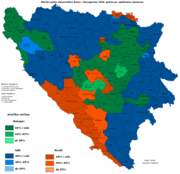 Ethnic map of Bosnia and Herzegovina, 2006 municipality data (est.). Bosnian Serbs - blue, Bosnian Croats - red, Bosnian Muslims - green. |
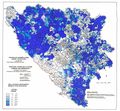 The territorial distribution of Serbs in the Socialist Republic of Bosnia and Herzegovina, according to the population census conducted in 1981 in the Socialist Federal Republic of Yugoslavia |
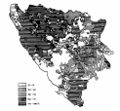 Territorial distribution of Orthodox Christian Serbs in 1921 in Bosnia and Herzegovina according to the Kingdom of Serbs, Croats and Slovenes population census |
 Bosnian Serbs in 1910; dark absolute and medium relative majority; light significant minority |
|
The distribution of the three main ethnic groups in Bosnia and Herzegovina in 1991 by municipalities. Bosnian Serbs are shown in red, Bosniaks/Bosnian Muslims in green, and Bosnian Croats in blue. The post-Dayton Inter-Entity Boundary Line is shown in white. |
References
|
||||||||